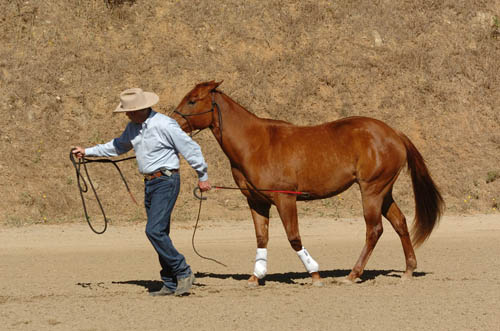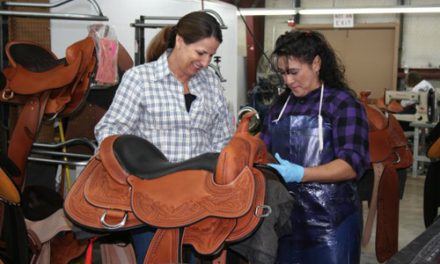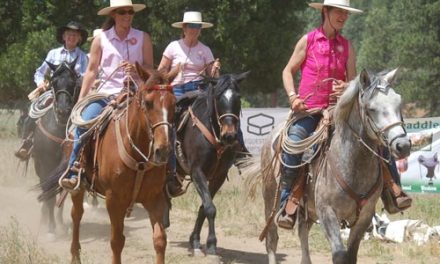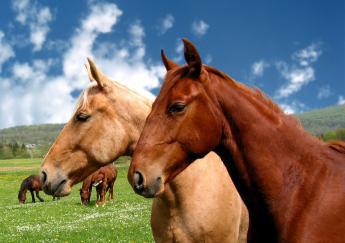 Many trainers lead with the horse behind but I like to lead with the horse beside me. I do this simply because I believe it is a matter of safety. As with so many aspects of horsemanship, there are two philosophies about the right way to lead a horse. First, the philosophy of leading with the horse behind is based on the principle that if you are going to be the leader, you need to lead. In the herd dynamic, which is the nature of a horse, this is very true, however there can be problems leading with the horse behind.
Many trainers lead with the horse behind but I like to lead with the horse beside me. I do this simply because I believe it is a matter of safety. As with so many aspects of horsemanship, there are two philosophies about the right way to lead a horse. First, the philosophy of leading with the horse behind is based on the principle that if you are going to be the leader, you need to lead. In the herd dynamic, which is the nature of a horse, this is very true, however there can be problems leading with the horse behind.
One problem with leading with the horse behind is that the horse will tend to drag and fail to be responsive to the lead line. The second problem is that if something spooks the horse from behind, there is a good chance the horse will run over you. In anything we do with a horse we want to set ourselves up for success, not just for us but for the horse too. Safety, for you as the owner and for your horse, is always the primary concern. If the horse knocks you over, bolts off and gets tangled up in equipment or runs through a fence because the flight instinct has kicked in, there is the possibility of injury to you both, not to mention medical and veterinary bills.
I used to lead horses behind me but after several times of being run over when a horse spooked, I looked at the situation and began to think about what was happening. The concept of being the leader is good but in actuality, it is not safe. I started to teach my horses to lead next to me, with me just in front of the horse’s shoulder. The first thing a horse does when it gets concerned is to lift its head. That is a signal for me that something is happening and to get out of the way. Depending on the situation, I can block the horse from moving into me.
 There are more accidents with horses on the ground than there are under saddle. A horse may walk or run into you or deliberately step on you. Stepping into your space is a horse’s way of asserting authority over you. The result is negative for both you and the horse in that you get hurt and horse becomes a bully even though the horse does not have the bully-type personality. When we are leading and the horse is beside us where we can see the head and the first quarter of the neck, we are in a position to see what the horse is doing and take appropriate action.
There are more accidents with horses on the ground than there are under saddle. A horse may walk or run into you or deliberately step on you. Stepping into your space is a horse’s way of asserting authority over you. The result is negative for both you and the horse in that you get hurt and horse becomes a bully even though the horse does not have the bully-type personality. When we are leading and the horse is beside us where we can see the head and the first quarter of the neck, we are in a position to see what the horse is doing and take appropriate action.
The other thing I see and have been asked about, is the horse who is always pulling the owner along. When a horse gets ahead of us, we need a tool to teach the horse that we are the leader. I start by teaching the horse stop and back up. The horse soon learns that if he gets ahead of me, I’m going to turn around, stop and back him up. I do this with authority and good energy. I am consistent with this response every time the horse goes ahead. Since horses are innately lazy and this activity motivates them to walk beside me. Very soon they are walking properly at what I call equine heel.
What if the horse lags behind even if you cluck to it? With a horse like this I take the end of the lead rope and swing it behind me as I am leading the horse or I take a dressage stick and reach behind to tap the horse to encourage forward movement.
Essentially, while we are being safe, we are teaching the horse to obey the forward cue and the back up cue. These are two very basic and fundamental elements in working with a horse. Proper leading then becomes a good exercise and reinforces two basic training elements.
When we are leading the horse beside us, we always know what the horse is doing and we are in communication with the horse. We can see what the ears are doing, we can see the horse’s eye and we are in a position to step out of the way before the horse rams into us or goes over the top of us. It is important to remember that when you keep yourself safe, your animal will be safe.





